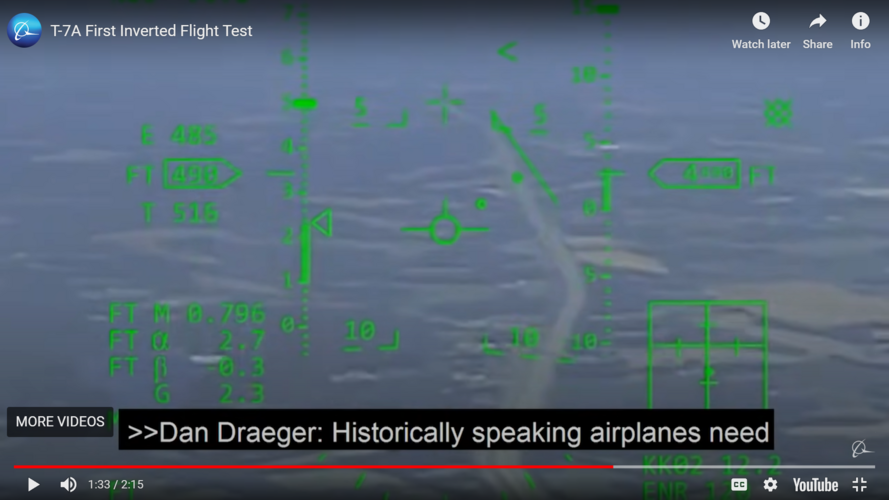The Boeing-Saab
T-7A Red Hawkadvanced trainer is making progress despite the COVID-19 pandemic, with 80 percent of developmental testing complete and the first engineering and manufacturing development aircraft under construction, Boeing officials reported July 14.
“We’ve had over 200 flights with our two test aircraft,” which sometimes fly multiple times a day, Thomas Breckenridge, company vice president for international sales, told reporters on a media call. Boeing does not call the jets prototypes, because they were built on production tooling, but the eventual production aircraft will be somewhat different than the initial version.
Dan Draeger, chief test pilot, said the test pace has slowed only a bit during the pandemic in order to maintain social distancing among pilots, ground crew, and technicians in the telemetry room. It has not been possible to fly the two aircraft simultaneously as a result, but they have been taken to 557 knots and testing in “negative G” conditions—to test whether lubricants and fuel flow properly when the jet is inverted—is nearly complete, he said. The advent of very hot weather in the St. Louis, Mo., area will facilitate hot-weather testing in the coming weeks, he noted.
Draeger said the Air Force’s threshold requirement was for the jet to be able to maneuver at 20 degrees angle of attack, but testing shows it can maneuver “and demonstrate excellent aircraft performance well above” 25 degrees AOA, which was the objective requirement.
USAF’s sustained turn requirement was 12.5 degrees per second and an instantaneous turn rate of 18 degrees per second, “and we’re in excess of those” requirements, Draeger said. The sustained G requirement was 6.5 and the objective 7.5, and he said the jet is performing “well above” the 6.5 level. “We’re definitely demonstrating fighter-like performance,” Draeger added.
Breckenridge declined to provide details of how far along the first engineering and manufacturing development aircraft is and when it might fly, other than to say production is underway.
Progress is also being made on the simulation and ground-based training system, company officials asserted. Pam Valdez, vice president of Air Force services, said the first simulator will be delivered in 2023, “just before” the delivery of the first all-up airplane. It will help get the first cadre of instructor pilots ready for the T-7, she said.
Boeing designed the T-7 to have “growth capability” to allow it to serve in Air Forces desiring capability like that of the F-5 or Alpha Jet, Breckenridge said, and the company is exploring options for marketing the aircraft as a light attack platform. The aircraft as it stands has a single hardpoint on the centerline, although Boeing officials have previously said there is room under the wings for additional weapon stations. “We’re very confident the T-7 is able to fulfill that role,” he said.
He also said Boeing is looking at a Navy requirement for a T-45 carrier aircraft trainer, and the company is “confident” it can offer a T-7-based solution. He declined to say whether the landing gear or other structure would have to be altered to meet the Navy’s requirement, which is for a jet that can “touch and go” on a flight deck, but doesn’t have to make an arrested landing.
The Air Force recently rolled out a new concept of operations for fighter pilot training,
called “Reforge,” that might require the purchase of more T-7s beyond the 351 called for in the 2018 contract. Breckenridge said Boeing has discussed it with the Air Force, but at this point the company has no idea how many additional T-7s might be needed. He said Boeing will remain “flexible” to support USAF pilot training in any way the service requires.
Valdez said the T-7 is “interoperable within its own network,” but there are no plans to integrate it with other jets through live, virtual, constructive training networks. She asserted that foreign customers could benefit from the jet because it would be interoperable with USAF trainers.
Discussions have continued with numerous potential customers on international sales even through COVID restrictions, Breckenridge noted. While he would not say when a first international aircraft could come off the line, “there is flexibility in the system to go over and above” the numbers already planned for the Air Force, so “we are able to meet needs that may arise from the international market.” He said it might be possible to start working on international contracts “as soon as the customer is ready for it.”
He also said Boeing is open to allowing licensed overseas production of the T-7 if the numbers required and conditions warrant.





